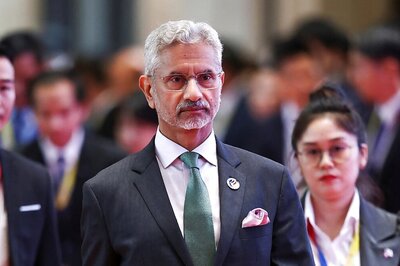
views
India is set to conduct the world’s largest democratic exercise in just over 30 days from now as the Chief Election Commissioner, Sunil Arora, on Sunday announced the polling schedule for the 2019 Lok Sabha elections.
The seven-phased general election for the 17th Lok Sabha will begin on April 11 2019, and will wind up on May 19, 2019. The results for the same will be declared on May 23, 2019.
News18.com looks at how this ‘festival of democracy’ has grown in enormity since the first general elections in 1951-52.
As announced by the CEC Arora on Sunday evening, there are at least 90 crore registered voters as of today in the country having a population of roughly 130 crore. This means that 69.23 percent of the citizens are eligible to vote. This is also an increase of 8.55 crores from the previous Lok Sabha elections in 2014 when there were 81.45 crore eligible voters.
When compared with the first general elections when Sukumar Sen was the CEC—appointed on March 21, 1950—the country had merely 17.32 crore voters (excluding Jammu and Kashmir). According to the 1951 Census, the population of the country was 35.66 crore. Again, this means that 48.56 percent of the citizens were eligible to vote.
It should be noted that during the first general elections in 1951-52, only citizens aged 21 years or older were allowed to vote, whereas now the cut-off age is 18 years. The voting age was lowered from 21 to 18 years through ‘The Constitution (Sixty-first Amendment) Act, 1988’.
The general election in 1951-52 was held in as many as 68 phases and over the course of almost four months between October 25 1951 and February 21, 1952. In contrast, the upcoming elections will be held in seven phases and would take 39 days to wind-up.
The total number of seats during the first elections were 489 whereas the country will hold elections on 543 parliamentary seats now.
According to the Election Commission of India data, there are at least 2,354 parties registered as of today in the country which is significantly higher than 53 parties that contested elections in 1951-52. Interestingly, the number of registered parties in 2019 are even more than the total number of candidates (1,849) who contested the general elections in 1951-52. In 2014, the number of candidates who were in the fray was 8,251. During the upcoming Lok Sabha polls, these numbers are expected to rise.
At least, 17.4 lakh VVPATs will be employed in as many as 10,35,918 polling stations compared with merely 2,23,611 polling booths in 1951-52, of which 27,527 were reserved for women.
In terms of post-poll numbers, the first general election in independent India saw a voter turnout of 45.7 per cent, whereas 66.4 per cent of the the eligible voters voted in 2014–highest ever.
Congress, which was the largest political party in 1951-52, won 364 seats in the parliament and bagged a vote-share of 44.99 per cent. It was followed by Communist Party of India (Marxist) at 16 seats and 3.29 per cent votes, Socialist Party with 12 seats and 10.59 votes, Kisan Mazdoor Party at 9 seats and 5.79 per cent of votes, People’s Democratic Front with 7 seats and 1.29 per cent of votes, Akhil Bharatiya Hindu Mahasabha with 4 seats and 0.95 per cent of votes, Bharatiya Jana Sangh at 3 seats and 3 per cent of votes. Independents had won 37 seats.
In 2014, Bharatiya Janata Party had won 282 seats with a vote-share of 31.3 per cent, followed by Congress with 44 seats with 19.5 of votes, All India Dravida Munnetra Kazhagam at 37 seats and 3.3 per cent of votes, All India Trinamool Congress with 34 seats and 3.9 per cent of votes and Biju Janata Dal at 20 seats and 1.7 per cent of votes.
Expenditure-wise, the first general election had cost Rs 10 crore to the exchequer compared with Rs 3,870 crore that the Centre spent in holding the Lok Sabha election in 2014.
In fact, the money spent to conduct the first general election is more or less equal to what a political party spends today on an individual candidate during the election campaign, if Jayprakash Narayan of the Lok Satta Party is to be believed. Narayan claims that “No party spends less than Rs 10 crore per constituency per candidate in India."
Expenditure to conduct the elections had crossed the Rs 100 crore-mark only in 1989 and went past the Rs 1,000 crore-mark in 2004.



















Comments
0 comment